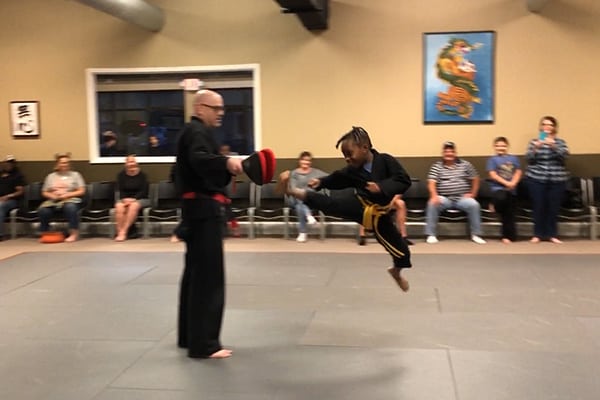Debunking Aikido Myths with IMAA
If you’ve spent any time on Reddit or other forums and martial arts communities, you’ve likely encountered the claim that “Aikido is useless.” As an Aikido practitioner and martial arts enthusiast, I understand where the skepticism comes from, especially in a world where mixed martial arts (MMA) has set new benchmarks for what is perceived as “effective.” However, I’d like to offer a perspective that goes beyond the surface of what the internet thinks and showcases why Aikido remains not only relevant but valuable for self-defense, personal growth, and physical mastery.
Understanding the Criticisms
To address the criticisms, we must first understand the core complaints:
- “Aikido doesn’t work in a fight.”
- “There’s no live sparring, so it’s unrealistic.”
- “The techniques are too choreographed.”
At first glance, these points may seem valid, especially when comparing Aikido to striking-based martial arts like Muay Thai or grappling systems like Brazilian Jiu-Jitsu. However, these critiques miss the bigger picture of what Aikido is, how it functions, and its role in the broader martial arts ecosystem.
Rebuttal 1: Aikido’s True Purpose is Not to Start Fights
Aikido’s founder, Morihei Ueshiba, designed the art as a way to neutralize conflict while causing minimal harm. Critics often point to combat sports like MMA and ask, “Why don’t we see Aikido in the UFC?” The answer is simple: Aikido wasn’t designed for a cage fight.
Aikido’s techniques are rooted in real-world situations where self-defense may mean disarming an aggressive attacker or escaping from a grab, it’s not teaching you to throw tactless punches for points or dominance. Many law enforcement agencies and self-defense instructors incorporate Aikido-based principles, such as joint locks and restraining holds, because they de-escalate dangerous situations without causing unnecessary harm. Aikido thrives in scenarios where the goal is survival, not entertainment.
For example: Imagine someone grabs you by the wrist and pulls you toward them. Aikido’s wrist control and throws offer an effective means of neutralizing this attack in a real-life setting, where retreat, rather than a prolonged fight, is the goal. This is especially necessary if you’re a woman being threatened or in a dangerous situation. If the attacker is stronger and bigger than you, you want to escape without harm and not stay in the situation longer.
Rebuttal 2: The Myth of “No Sparring” in Aikido
One of the loudest criticisms is that Aikido lacks live sparring, which supposedly makes it ineffective. While Aikido doesn’t have sparring in the same form as boxing or Brazilian Jiu-Jitsu, it does have randori. Randori is a form of free-flowing practice where the practitioner defends against multiple attackers. Randori emphasizes dynamic movement, timing, and the ability to read and react to opponents’ actions.
Additionally, ukemi (the art of falling and receiving techniques) is a form of pressure testing that is often overlooked. Learning how to recover from throws and rolls under various speeds and intensities trains resilience, spatial awareness, and adaptability. Aikido’s practice of “softening” an attacker’s force by redirecting it is not something easily practiced in a point-scoring sport, it requires continuous adaptation against resistance.
Rebuttal 3: Choreographed Movements Have Purpose
The argument that Aikido is “too choreographed” is often misunderstood. Yes, many Aikido drills are pre-arranged in the same way that kata in karate or forms in kung fu are choreographed. However, the purpose is not to create rigid patterns but to internalize movements so they become second nature under stress.
Once a practitioner internalizes these movements, they can be applied fluidly in unpredictable scenarios. Think of it like learning a language: you start with basic grammar and vocabulary before engaging in a spontaneous conversation. Aikido’s choreographed sequences teach body mechanics, balance, and energy flow. These elements are critical for success when things become unpredictable.
Aikido is Not a Shortcut, and That’s the Point
Aikido often gets a bad rap because its effectiveness isn’t immediately obvious. It’s not an art designed to deliver knockout punches in a month of training. It requires patience, consistent practice, and a willingness to gain internal strength and control. In contrast to some striking or grappling arts, where success can come quickly with brute force, Aikido emphasizes long-term refinement and self-mastery.
Morihei Ueshiba himself once said:
“True victory is victory over the self.”
Many who dismiss Aikido as useless are looking for an instant path to dominance rather than an enduring path to peace and preparedness. Yet for those willing to put in the time, Aikido provides powerful tools not only for self-defense but also for leading a more balanced and resilient life.
The Real Measure of a Martial Art’s Worth
Is Aikido perfect? No. But neither is any other martial art. Each art has limitations, especially when taken out of context. A wrestler may struggle against a striking specialist, while a boxer may find themselves outmatched on the ground. The key is understanding what Aikido offers and training with clarity of purpose.
If your goal is to dominate an opponent in a combat sport, Aikido may not be the right fit. But if your goal is to protect yourself and others while avoiding unnecessary harm and fighting, Aikido provides a valuable and unique toolkit that few other arts can match.
Aikido’s Value Lies in Its Depth, Not Its Flash
The criticisms of Aikido often stem from misunderstanding its purpose or encountering schools that fail to properly teach its principles. When trained authentically, Aikido becomes more than a martial art, it becomes a way of life that builds resilience, mindfulness, and a calm confidence that transcends the mat.
So the next time someone calls Aikido “useless,” consider asking what their criteria are for usefulness. Aikido offers an important reminder: strength without control is weakness. And true mastery comes not from overpowering others, but from mastering yourself.
Enroll Now!
At Innovative Martial Arts Academy, our Martial Arts training offers men, women, and children the opportunity to challenge their bodies and minds without the threat of injury and intimidation. Take on the best training in disciplines like Aikido, Kenpo Karate, and Kali, and build your skills one day at a time with the help of our dedicated instructors. Children ages 5-7 are encouraged to join our Young Dragons, and ages 3-5 are welcome in our Lil Ninjas program.
We are proud to serve families across Wake Forest, Wakefield and the surrounding area with a rewarding experience that can set you or your child up for success in all aspects of life. If you’re interested in learning about our martial arts program, contact us at 919.562.4663, or visit our website.
*Follow us on Instagram | Facebook
Want To Read More About Martial Arts?</H2>
Take a look at some of our other articles about martial arts and IMAA’s course offerings? Check out the following related blog articles:


